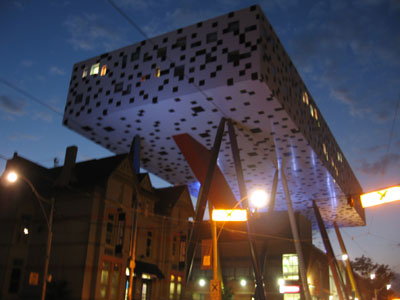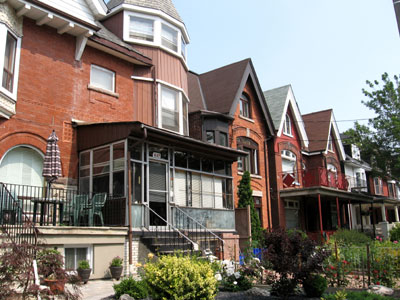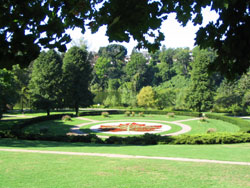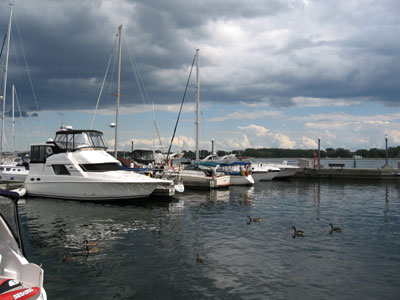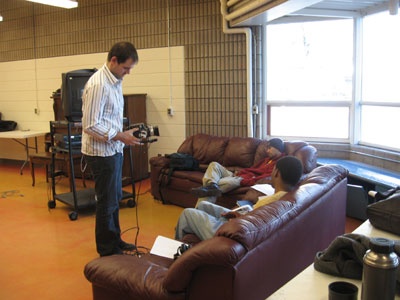Goods sold include fruits and vegetables, meat and seafood, low cost clothing and general merchandise, all of which are sold at very reasonable prices. Recently there has been a noticeable local increase in Latin American immigrants, testament to the fact that Toronto’s demographics continue to be in flux.

Ducks hanging in Chinatown display windows
The same story applies even more to Toronto’s Kensington area, roughly bounded by Spadina Avenue, College Street, Queen Street and Bellevue Avenue. As Bruce explained, it is one of Toronto’s most ethnically diverse and eclectic neighbourhoods and has been attracting immigrants from different countries of origin for the last 130 years or so. Originally the Denison estate, the Kensington area became a residential area for Irish and Scottish immigrant labourers. The small working-class houses in this historically inexpensive area have been inhabited by successive waves of immigrants from different places. From 1910 onwards, Jewish immigrants from Eastern Europe as well as some Italians started to stream into the area. The entire Kensington area became known as “the Jewish Market”, and about 60,000 Jewish residents lived here in the 1920s and 1930s who worshipped in about 30 local synagogues.

The Anshei Minsk Synagogue
We stopped at the Minsker Synagogue at 10 St. Andrew Street, home of the Congregation Anshei Minsk, Toronto’s Downtown Synagogue. Construction of the synagogue commenced in 1922 and was finally completed in 1930. As a result of the out-migration of many of the Jewish residents from Kensington, today it is one of the few synagogues still in active operation in downtown Toronto.
 |
 |
 |
| Colourful murals | Unique shops | Fresh veggies and fruits |
Captivated by the colourful and unusual variety of stores we walked through narrow streets filled with a jumble of vintage clothing stores, bakeries, restaurants, shops selling anything from fish, cheese and meat to dry goods and assorted merchandise. At about 7:30 pm most of the stores had closed or were in the process of closing, but the diverse and unusual storefronts and murals illustrate the Bohemian flavour of this area. Bruce pointed out numerous favourite hangouts: places such as Cob’s Bread, Graffiti’s Bar and Grill, My Market Bakery, the Chocolate Addict and many other unique nooks and crannies illustrate the free-spirited character of this unusual neighbourhood. At the intersection of St. Andrew and Augusta we stopped to admire a “half a house” that was attached to some flat-roofed houses and the complex was then capped off on the other side by another “half a house”.

Two half houses, separate by two flat-roofed structures
One of the most poignant symbols of Toronto’s multi-ethnic mixing is a restaurant called the “Hungary Thai”, an eatery that surprisingly combines European and Asian culinary traditions originating in Hungary and Thailand. There is no better area than Kensington Market to come face to face with Toronto’s culturally diverse makeup. Today’s Kensington features residents and merchants from all over the world, including people of Latin, Carribean, European and Asian origin.

The Hungary Thai restaurant
Southwest of Augusta Avenue we turned onto Bellevue Square Park, a green space that is frequented by a very Bohemian crowd of people, representing some of Toronto’s artists and counterculture. Kensington Market is one of the few areas that features Cannabis cafes and products, and there is a distinct marijuana culture that pervades the area, particularly on Bellevue Square Park. The northwest end of the park features a statue of Al Waxman (1935 to 2001), a Toronto actor who starred in a popular television series “The King of Kensington” and was involved in numerous charitable organizations and events. Bruce pointed out that Al’s wife Sara is immortalized on a bench right next to the statue in a carving that says “Sara loves Al”.

Statue of Al Waxman, a beloved figure in Kensington
Right opposite the Al Waxman statue at the corner of Bellevue Avenue is another relic from Kensington’s Jewish history. The Kiever Synagogue on Denison Square was built in 1912. Its twin towers are crowned with Stars of David which give it a distinct middle-eastern or Byzantine feel. Although many Jewish residents have left the Kensington area over the last few decades to move further north in the City, the Kiever Synagogue continues to be active and to offer religious services every Sabbath as well as educational services to the remaining Jewish population.

We proceeded southwards on Augusta Avenue until we reached Queen Street. At the corner of Augusta and Queen we stopped and Bruce made us aware of one of the emblematic statues guarding the entrances of Kensington: an oversized cat prancing on a globe, an appropriately offbeat symbol of this colourful neighbourhood.

Cat on a globe
Across the street Bruce pointed out the former Alexandra Park public housing complex that has been renamed the Atkinson Housing Co-op. Bruce explained that this residential complex was a major urban planning mistake and had become one of Toronto’s most crime-ridden areas. In 2003 the former Alexandra Park became Canada’s first public housing complex to be converted into a tenant-managed, non-profit housing cooperative, a move which has greatly improved the safety in this area.

Graffiti in Kensington
At the intersection of Dundas and Queen Streets, right in the heart of Chinatown, Bruce stopped again to show us the Art Deco Victory Theatre, a former vaudeville theatre. He also explained that this theatre had at some point morphed into the Victory Burlesque, home of famous Gypsy Rose Lee, the famous burlesque dancer who became known for putting the “tease into striptease”.

Beautiful Victorian side street in Kensington
